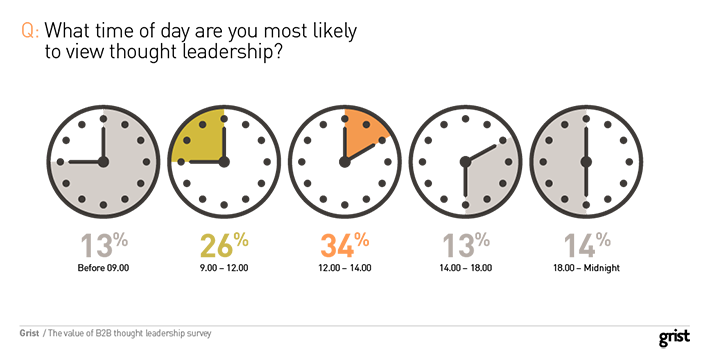At Grist, we wanted to understand when senior executives preferred to read thought leadership content. With the help of the first Value of B2B Thought Leadership Survey this is what we discovered.
There’s a phrase for it. It’s called ‘al desko’ and refers to our behaviour in the middle of the working day. The long – and often boozy – lunch is a thing of the past. It’s been replaced by a sandwich – often limp – or salad – ditto – in front of the computer where we catch up on emails and a lengthening reading list.
Sound familiar? Well, it would appear that the al desko phenomenon is fully embraced by your audience, too, according to the findings of Grist’s most recent research. The Value of B2B Thought Leadership Survey: How the C-suite View and Use Content Marketing sought to understand the digital consumption habits of senior executives in FTSE350 firms. And when asked at what point during the day they are most likely to view thought leadership content, 34 per cent of senior executives selected the 12 noon to 2pm slot. The working morning, between 9am and 12 noon, was the second most popular (26 per cent), while as many said they viewed thought leadership content between 6pm and midnight (14 per cent) as they did between 2pm and 6pm.

Lunchtimes are sacred, it would seem. And al desko should act as a call to arms for creators of compelling thought leadership.
On one level, this preference appears logical. On another, it jars with other emerging consumption trends. Namely, the ubiquity of smart devices that means people can access web-based content remotely, on the move and at any time of the day.
Look at consumption among Facebook’s 1.8 billion monthly active users every month and you will see that activity doesn’t peak at noon but at around 9pm instead. That shift in behaviour is a product of the smartphone. Consider that 1.1 billion people access this particular social network via a mobile device every day.
But your target audience isn’t behaving quite like the Facebook generation – not just yet, at least. In a B2B relationship, lunchtime remains the sweet spot. Consumption habits remain more conventional.
The research didn’t just seek to understand the best time of day to publish content, it also sought to find out which were the best days of the week to push out articles, blog posts, videos and so on. According to the Grist findings, two thirds of senior executives preferred Mondays, just over half selected Friday’s (52 per cent) while – further down the list – 22 per cent selected Saturday and 20 per cent selected Sunday.
There are two ways to read the Saturday and Sunday figures. One is that the weekend remains the most inactive part of the week. Alternatively, the fact that one in five of your target audience are ready to receive work-based content on their days of rest is a potential opportunity. Given there is less digital noise at the weekend, the chance that a perfectly constructed and targeted message will find its way through is high. And with fewer distractions, the recipient is likely to spend more time with it.
So what is the underlying message? That your clients want to hear from you at lunchtime, especially Monday and Friday lunchtimes.
Or, perhaps that should be they are ready to read it at lunchtime which is not quite the same thing. It may be that an article published at mid-morning, a newsletter sent early morning, or a Tweet posted overnight providing a link to a great piece of thought leadership are all, ultimately, engaged with at lunchtime.
Our advice is simple – get to know your clients’ media consumption habits. Experiment with A/B testing to find out. Send a newsletter to half your audience early lunchtime and another, identical email, at 7am. See which performed best, which had the greater open rate and the larger number of clicks on the content links inside. Experiment with social media posts – the same LinkedIn or Twitter post but at different times of the day. Compare engagement rates.
Learn from the analytics, in other words. And if you are reading this al desko, keep those crumbs out of the keyboard.
Click here to download ‘The Value of B2B Thought Leadership Survey: How the C-suite View and Use Content Marketing’



